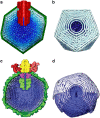Packaging double-helical DNA into viral capsids: structures, forces, and energetics
- PMID: 18487310
- PMCID: PMC2440449
- DOI: 10.1529/biophysj.108.131797
Packaging double-helical DNA into viral capsids: structures, forces, and energetics
Abstract
Small, icosahedral double-stranded DNA bacteriophage pack their genomes tightly into preformed protein capsids using an ATP-driven motor. Coarse-grain molecular-mechanics models provide a detailed picture of DNA packaging in bacteriophage, revealing how conformation depends on capsid size and shape, and the presence or absence of a protein core. The forces that oppose packaging have large contributions from both electrostatic repulsions and the entropic penalty of confining the DNA into the capsid, whereas elastic deformations make only a modest contribution. The elastic deformation energy is very sensitive to the final conformation, whereas the electrostatic and entropic penalties are not, so the packaged DNA favors conformations that minimize the bending energy.
Figures






Similar articles
-
Structural and thermodynamic principles of viral packaging.Structure. 2007 Jan;15(1):21-7. doi: 10.1016/j.str.2006.11.013. Structure. 2007. PMID: 17223529
-
Visualization of bacteriophage T3 capsids with DNA incompletely packaged in vivo.J Mol Biol. 2008 Dec 31;384(5):1384-99. doi: 10.1016/j.jmb.2008.10.012. Epub 2008 Oct 14. J Mol Biol. 2008. PMID: 18952096 Free PMC article.
-
Polymorphism of DNA conformation inside the bacteriophage capsid.J Biol Phys. 2013 Mar;39(2):201-13. doi: 10.1007/s10867-013-9315-y. Epub 2013 Apr 12. J Biol Phys. 2013. PMID: 23860869 Free PMC article.
-
Pulsed field agarose gel electrophoresis in the study of morphogenesis: packaging of double-stranded DNA in the capsids of bacteriophages.Electrophoresis. 1993 Apr;14(4):271-7. doi: 10.1002/elps.1150140148. Electrophoresis. 1993. PMID: 8500457 Review.
-
Molecular mechanisms in bacteriophage T7 procapsid assembly, maturation, and DNA containment.Adv Protein Chem. 2003;64:301-23. doi: 10.1016/s0065-3233(03)01008-8. Adv Protein Chem. 2003. PMID: 13677051 Review.
Cited by
-
To build a virus on a nucleic acid substrate.Biophys J. 2013 Apr 2;104(7):1595-604. doi: 10.1016/j.bpj.2013.02.005. Biophys J. 2013. PMID: 23561536 Free PMC article.
-
Agarose gel electrophoresis reveals structural fluidity of a phage T3 DNA packaging intermediate.Electrophoresis. 2012 Jan;33(2):352-65. doi: 10.1002/elps.201100326. Electrophoresis. 2012. PMID: 22222979 Free PMC article.
-
Ion-dependent DNA configuration in bacteriophage capsids.Biophys J. 2021 Aug 17;120(16):3292-3302. doi: 10.1016/j.bpj.2021.07.006. Epub 2021 Jul 13. Biophys J. 2021. PMID: 34265262 Free PMC article.
-
Mutual Interplay between the Human Cytomegalovirus Terminase Subunits pUL51, pUL56, and pUL89 Promotes Terminase Complex Formation.J Virol. 2017 May 26;91(12):e02384-16. doi: 10.1128/JVI.02384-16. Print 2017 Jun 15. J Virol. 2017. PMID: 28356534 Free PMC article.
-
Viral Genomic DNA Packaging Machinery.Subcell Biochem. 2024;104:181-205. doi: 10.1007/978-3-031-58843-3_9. Subcell Biochem. 2024. PMID: 38963488 Free PMC article. Review.
References
-
- Richards, K. E., R. C. Williams, and R. Calendar. 1973. Mode of DNA packing within bacteriophage heads. J. Mol. Biol. 78:255–259. - PubMed
-
- Hall, S. B., and J. A. Schellman. 1982. Flow dichroism of capsid DNA phages. II. Effect of DNA deletions and intercalating dyes. Biopolymers. 21:2011–2031. - PubMed
-
- Earnshaw, W. C., J. King, S. C. Harrison, and F. A. Eiserling. 1978. The structural organization of DNA packaged within the heads of T4 wild-type, isometric and giant bacteriophages. Cell. 14:559–568. - PubMed
-
- Earnshaw, W. C., and S. C. Harrison. 1977. DNA arrangement in isometric phage heads. Nature. 268:598–602. - PubMed
Publication types
MeSH terms
Substances
Grants and funding
LinkOut - more resources
Full Text Sources

